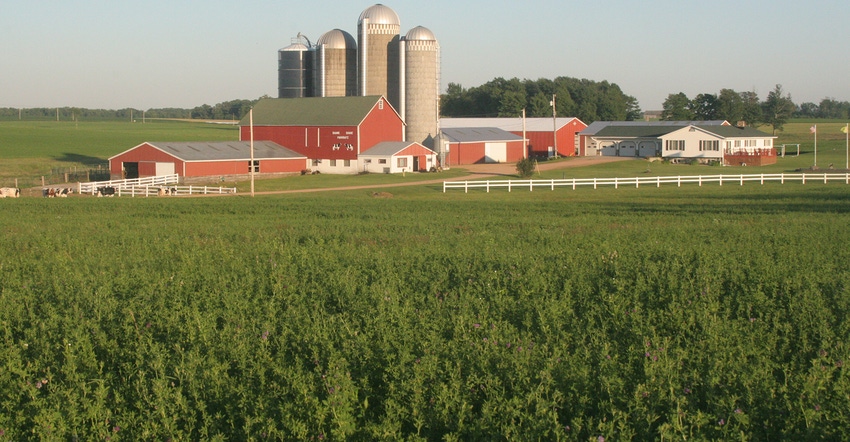
University of Wisconsin ag economists who spoke at the annual Wisconsin Agricultural Outlook Forum held Jan. 25 in Madison anticipate 2018 will be another challenging year for Wisconsin farmers.

Continued low prices for crops and milk are clearly taking a toll on Wisconsin farmers.
“As capital has been drained due to tight margins, farmers have increased borrowing,” Mitchell said. “Farm Service Agency, the lender of last resort, said they made a record number of loans in 2017.”
Mitchell also reported that Chapter 12 bankruptcy filings have been high on Wisconsin farms. “We had 41 between Oct. 1, 2016, and Sept. 30, 2017,” he said. “The only state with more is Georgia.”
While there were farm bankruptcies across the state, the western part of the state appears to be the most stressed.
“The U.S. Western District of Wisconsin ranked No. 1 in the nation in farm bankruptcy filings last year,” Mitchell said. “Farmers are very stressed. It’s crop and dairy farmers, large and small farmers, and organic and conventional farmers.”
Mitchell did share some good news from 2017 for Wisconsin farmers. Land values in the Dairy State rose $300 per acre, or 9.5%, in 2017 compared to 2016.
“This increase is the largest percentage increase nationally except for California,” he noted. “Wisconsin is an outlier among Midwestern states, with a large increase. Only Minnesota and Iowa showed increases in land values in 2017, but much smaller, with other states showing no change or decreases in farm real estate values. The continued strength of the dairy industry in the long term has put upward pressure on cropland prices in the state.”

Mark Stephenson (left), UW-Madison director of dairy policy analysis, says while 2017 wasn’t a great milk price year for Wisconsin farmers, the Class III price averaged $16.17 per cwt, $1.30 more than in 2016. He says the second half of 2017 was the most difficult for dairy producers. Stephenson said the Class III milk price in August was $16.50 per cwt. By January, it had fallen to $13.90.
“By mid-2017, milk prices felt as though they were on their way to recovery,” Stephenson said. “We were about three years into price declines from the highs of 2014, and prices had clearly hit their bottom in May of 2016. But prices never really showed enthusiasm, and as we finished 2017, it was clear that market sentiment is negative once again, and farm milk prices are declining as we begin 2018.”
Impacts on farm milk prices have come from local, regional and international effects, and for Wisconsin producers, none of those has been positive, Stephenson said — but the international effects have probably been the most impactful.
“The top five milk-exporting countries include the largest as the European Union and only slightly smaller New Zealand,” he said. “The U.S. is the third-largest exporter, followed by Australia and Argentina.”
According to Stephenson, the U.S. began its role in world export markets sometime around 2005, and exported product has increased from 3% to 4% of milk production to 14% to 16% today. “Simply put, the U.S. dairy industry is now dependent on exports in a way that we were not a little more than a decade ago.”
The U.S. economy has been strong and domestic dairy sales have been good, but there have been regional shifts occurring in milk markets, Stephenson said.
The Southeastern states have been in decline for many years, and as the population of that region continues to grow, there is a significant deficit of milk and dairy products there, he explained. California and other states in the West have a surplus in milk production, but as a result of drought, low profit margins and other problems, milk production has declined over the last three years.
“But the northeastern quadrant of the U.S., which includes the Upper Midwest, has been on a major growth surge. Michigan has doubled their milk production over the last 15 years, and it is now the fifth top-producing dairy state. New York has had significant growth in milk production over the past five years, but no state has increased milk production more than Wisconsin in the last few years,” he said. “Collectively, these three states have increased milk production about 15 million pounds of milk per day over the last three years, which is equivalent to the capacity of three large dairy processing plants.”
Michigan has not had sufficient capacity to process all of its milk, and much of the extra has found a processing home in nearby states, from New York and Pennsylvania to Wisconsin, Stephenson said. Plants throughout the region have more milk than they need, and it is expensive to transport raw milk long distances, he added. This has put downward pressure on over-order premiums throughout the region. As a result, Wisconsin dairy farmers have received lower milk premiums. Michigan has experienced milk prices below federal order minimums as farmers absorb the costs of transportation and the sale of milk at distressed prices.
Stephenson said he is not optimistic about milk prices in the short run.
“I am forecasting that farm milk prices will continue to decline through the first quarter of 2018 and will probably hit bottom in April or May,” he said. “At that point, prices should begin to increase through the rest of the year. My forecast is that milk prices will look a lot like 2016 prices and will give back the gains of 2017. I think the 2018 Class III milk price will be $1.35 lower than 2017.”

Brenda Boetel (left), ag marketing specialist at UW-River Falls, said corn and soybean prices have shown very little change from this time last year.
“Large world production and carryover is weighing on the markets, and will continue to do so in 2018,” she said. “Continued price weakness should be expected without a production shortfall in one of the world’s major producers.”
Due to large stocks generated from five consecutive large crops in the U.S., corn prices are depressed, Boetel continued. USDA projections in the World Agricultural Supply and Demand Estimates indicate 2017 U.S. corn production fell 3.6% from 2016. National yield was up to 176.6 bushels per acre, and Wisconsin’s yield was 174 bushels. U.S. demand remains strong, though it’s down 1% from last year.
“Corn exports for the current marketing year are down significantly from last year. As of mid-December, export inspections were down 38% from the previous year, and exports had only met 18.5% of the USDA projections, even though 35% of the marketing year was complete. Unless the export pace increases in the next weeks, the USDA will likely reduce export projections for the 2017-18 marketing year,” Boetel said. “Higher prices will require a production shortfall in marketing-year 2018-19. Barring that shortfall, 2018 harvest prices should be similar to 2017 harvest prices to 10 cents lower per bushel.”
Boetel said soybeans are currently trading at prices higher than the projected ending stocks would suggest. “Similar to corn, soybeans have had high production for the last five years; and U.S. production has increased every harvest since 2013. 2017 saw an increase in production, even with a decrease in yield of 3 bushels per acre, due to the additional 6.8 million acres of soybeans planted in 2017.”
Boetel explained that world production of soybeans is also high, although lower from a year ago due to reduced production in the U.S. and Argentina. “Planted acreage for 2018 will likely be slightly higher, given the current pricing structure when compared to corn. 2018 may see more acres of soybeans than corn planted for the first time since 1983,” she said.
According to Boetel, 2017 was a good year for poultry, pork and beef producers
“Demand has been strong, both domestically and through exports. Per capita pork, poultry and beef production increased in 2017 and will continue to increase in 2018,” she said. “Per capita production levels in pork and poultry will likely hit record levels for the fourth year in a row due to the expansion driven primarily from weak grain prices.
“Calendar-year 2017 provided a return to profitability for the cattle industry, and supported continued growth in the cattle herd,” Boetel said. “Beef production in 2018 is expected to grow at a faster rate than either pork or poultry. Per capita beef consumption was up 2.4% in 2017 and will increase another 2.4% in 2018.”
About the Author(s)
You May Also Like






